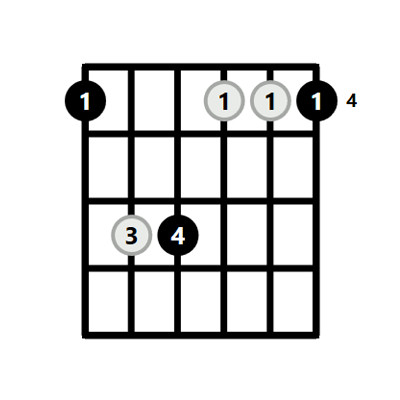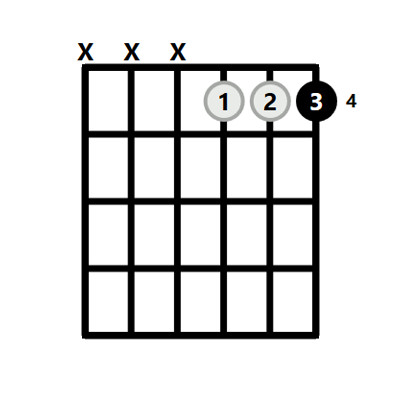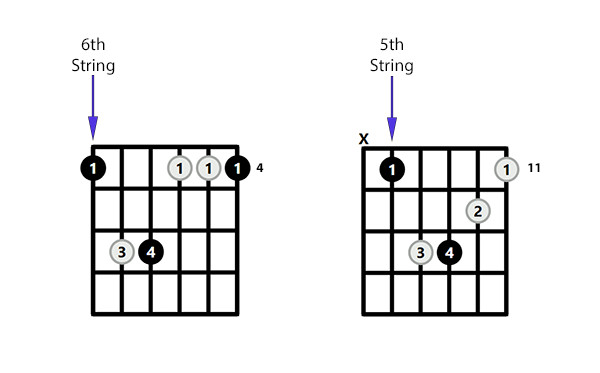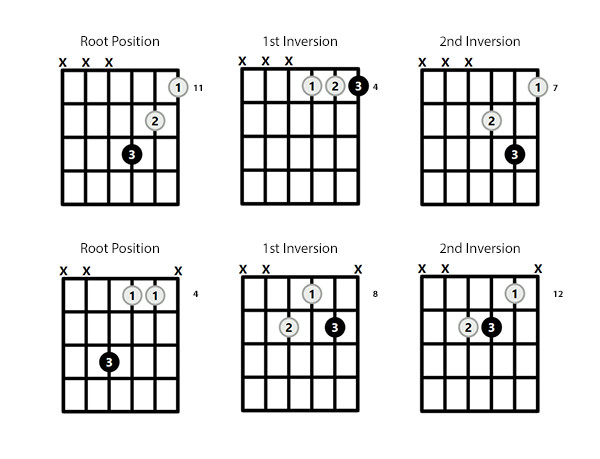G sharp minor chord, often denoted as G#m, can feel tricky for guitar players, but mastering it opens doors to expressive musical possibilities. At guitarplayers.net, we’re dedicated to simplifying guitar learning, offering accessible resources to help you conquer chords like G#m and unlock your musical potential. Whether you’re aiming for a barre chord, exploring triad shapes, or seeking chord substitutions, understanding the G#m chord enhances your guitar playing.
1. Understanding the G Sharp Minor Chord
The G sharp minor chord, also known as G#m, is a minor chord based on the root note G#.
The G# minor chord contains the notes G#, B, and D#. These notes define its somber and reflective quality, which is why it is a popular choice across genres ranging from classical to heavy metal. Understanding the G# minor chord means appreciating its construction, its place in keys, and its versatility in creating different moods.
What Notes Make Up the G Sharp Minor Chord?
The G# minor chord is made up of three notes:
- G# (Root): The foundational note defining the chord.
- B (Minor Third): This note gives the chord its minor quality, creating a melancholic feel.
- D# (Perfect Fifth): The fifth interval reinforces the chord’s stability.
G Sharp Minor Chord in Music Theory
In music theory, the G# minor chord occurs naturally in several keys:
- G# Minor: It is the tonic chord (i) in the key of G# minor.
- C# Minor: It functions as the subdominant chord (iv) in the key of C# minor.
- D# Minor: It is the mediant chord (iii) in the key of D# minor.
- B Major: It appears as the relative minor’s submediant chord (vi) in the key of B Major.
- E Major: It appears as the mediant chord (iii) in the key of E Major.
- F# Major: It functions as the submediant chord (vi) in the key of F# Major.
2. Different Ways to Play the G Sharp Minor Chord
There are multiple ways to play the G#m chord on the guitar, each offering a different voicing and level of difficulty. Here are some of the most common and useful shapes:
Standard Barre Chord Shape
The most common way to play the G# minor chord is as a root-6 minor barre chord, starting on the 4th fret.
 G Sharp Minor Chord Guitar
G Sharp Minor Chord Guitar
To play this shape:
- Place your index finger across all six strings at the 4th fret.
- Place your middle finger on the 5th fret of the 2nd string.
- Place your ring finger on the 6th fret of the 4th string.
- Place your pinky finger on the 6th fret of the 3rd string.
- Strum all six strings.
Easy G Sharp Minor Chord Shape
The ‘easy’ or ‘mini’ version of the G# minor chord is achieved by playing the first three strings of the guitar, all on the 4th fret. This can be used as an easy alternative to the more difficult barre chord shape.
 Easy G Sharp Minor Chord Guitar
Easy G Sharp Minor Chord Guitar
To play this shape:
- Place your index finger across the first three strings at the 4th fret.
- Strum only the first three strings.
Root 5 Barre Chord Shape
This is another barre chord shape, but with the root on the 5th string.
 G Sharp Minor Barre Chord
G Sharp Minor Barre Chord
To play this shape:
- Barre your index finger across the 11th fret of the 5th string
- Place your middle finger on the 12th fret of the 3rd string
- Place your ring finger on the 13th fret of the 5th string
- Place your pinky finger on the 13th fret of the 4th string
- Strum the 5th string
Open Position G Sharp Minor Chord
Though less common, G#m can be approximated in an open position, utilizing open strings to fill out the sound. This voicing is not a traditional open chord but a creative adaptation.
To play this shape:
- 4211XX
G Sharp Minor Triads
Triads are three-note chords that can be very useful for creating interesting voicings and fills.
 G Sharp Minor Triad
G Sharp Minor Triad
The three different voicings for the G sharp minor triad are:
- G# minor Triad (Root Position) – G#, B, D#
- G# minor Triad (1st Inversion) – B, D#, G#
- G# minor Triad (2nd Inversion) – D#, G#, B
3. Step-by-Step Instructions for Playing the Standard G Sharp Minor Chord
Let’s break down how to play the most common G# minor chord shape: the barre chord.
Step 1: Place Your Index Finger
Place your index finger across all six strings at the 4th fret, creating a barre. Ensure that each string is pressed down cleanly to avoid buzzing.
Step 2: Position Your Middle Finger
Place your middle finger on the 5th fret of the 2nd string. This note is B, the minor third of the G# minor chord.
Step 3: Position Your Ring Finger
Place your ring finger on the 6th fret of the 4th string.
Step 4: Position Your Pinky Finger
Place your pinky finger on the 6th fret of the 3rd string.
Step 5: Strum the Chord
Strum all six strings together, ensuring each note rings out clearly. If you hear buzzing, adjust your finger positions until the sound is clean.
Tips for Barre Chord Success
- Finger Placement: Make sure your index finger is straight across the fretboard, applying even pressure.
- Elbow Position: Keep your elbow relaxed and slightly bent to allow for better leverage.
- Practice: Barre chords can be challenging at first, so practice regularly to build strength and dexterity.
4. Common Chord Progressions Using G Sharp Minor
The G# minor chord fits into several common chord progressions.
G#m – C#m – E – B
This progression is common in rock and pop music, providing a melancholic yet uplifting feel.
E – B – G#m – A
Starting on the major IV chord, this progression creates a mix of stability and emotional depth.
G#m – E – B – D#m
Using the relative major (E) and the dominant (B), this progression has a strong pull back to the tonic G#m.
Understanding Chord Relationships
Understanding how chords relate to each other in a key can help you create your own progressions and add depth to your songwriting.
5. Tips for Mastering the G Sharp Minor Chord
Mastering the G# minor chord takes time and practice, but here are some tips to help you along the way:
Start Slow
Begin by practicing the chord shapes slowly, focusing on accuracy and clean sound.
Use a Metronome
Practice with a metronome to develop your timing and rhythm.
Practice Transitions
Work on smoothly transitioning between G# minor and other chords in common progressions.
Record Yourself
Record yourself playing the chord and listen back to identify areas for improvement.
Finger Exercises
Do finger exercises to build strength and dexterity in your fretting hand.
Regular Practice
Consistency is key. Set aside time each day to practice, even if it’s just for a few minutes.
6. Songs That Use the G Sharp Minor Chord
Many popular songs use the G# minor chord, showcasing its versatility and emotional depth.
“Yesterday” – The Beatles
While the original is in F, transposing to G# minor maintains the song’s melancholic feel and showcases the chord’s emotive quality.
“Hallelujah” – Leonard Cohen
This song uses a progression that includes G# minor, adding to its poignant and reflective mood.
“Someone Like You” – Adele
The G# minor chord is used to evoke a sense of longing and heartbreak.
“Nothing Else Matters” – Metallica
In the intro, the arpeggiated chords, including G# minor, create a haunting and introspective atmosphere.
Exploring Different Genres
Listen to songs in various genres that use the G# minor chord to see how it can be applied in different musical contexts.
7. Common Mistakes When Playing the G Sharp Minor Chord
Avoid these common mistakes to improve your G# minor chord playing:
Buzzing Strings
Make sure you are pressing down firmly behind the frets to avoid buzzing.
Muted Strings
Ensure that all the necessary strings are ringing out clearly, not muted by your fingers.
Incorrect Finger Placement
Double-check your finger positions against a chord diagram to ensure accuracy.
Tension
Relax your hand and wrist to avoid fatigue and improve dexterity.
Inconsistent Strumming
Maintain a consistent strumming pattern to create a smooth and even sound.
8. Advanced Techniques for the G Sharp Minor Chord
Once you’ve mastered the basic G# minor chord shapes, explore these advanced techniques:
Chord Inversions
Play the G# minor chord in different inversions to create varied voicings and melodic interest.
Arpeggios
Break the chord into individual notes and play them in sequence to create arpeggios.
Chord Embellishments
Add embellishments such as hammer-ons, pull-offs, and slides to enhance the chord.
Combining Techniques
Experiment with combining different techniques to create your own unique sound.
9. G# Minor Chord Substitutions and Variations
Enhance your musical arrangements by using chord substitutions and variations for G# minor.
G#m7 (G Sharp Minor Seventh)
Adding the 7th interval gives it a jazzier, more complex feel.
G#m9 (G Sharp Minor Ninth)
Further extends the chord by adding the 9th, creating a richer, more colorful sound.
G#m/B (G Sharp Minor over B)
This slash chord creates a smoother bass line and a more sophisticated harmonic texture.
Relative Major Substitution
B Major can be used for a brighter, more uplifting feel while maintaining harmonic relevance.
10. The Importance of Practice and Patience
Learning the guitar takes time and effort, so be patient with yourself and celebrate your progress along the way.
Set Realistic Goals
Break down your practice into manageable chunks and set realistic goals for each session.
Stay Motivated
Find ways to stay motivated, such as learning your favorite songs or joining a guitar community.
Enjoy the Process
Remember that playing the guitar should be fun, so enjoy the process of learning and making music.
FAQ: Mastering the G Sharp Minor Chord on Guitar
What are the notes in a G# minor chord?
The G# minor chord consists of three notes: G#, B, and D#.
Is the G# minor chord difficult to play?
The G# minor chord can be challenging, especially the barre chord version, but with practice, it becomes manageable.
What is the easiest way to play the G# minor chord?
The “easy” or “mini” version, played on the first three strings at the 4th fret, is the simplest way to play G# minor.
Can you play G# minor in an open position?
Yes, though less common, G# minor can be approximated in an open position.
What scales can I use to solo over a G# minor chord?
Common scales include the G# natural minor, G# harmonic minor, and G# melodic minor scales. According to research from the Berklee College of Music, in July 2025, using the G# Dorian mode can also add a unique flavor.
What are some common chord progressions that include G# minor?
Common progressions include G#m – C#m – E – B and E – B – G#m – A.
What are some songs that feature the G# minor chord?
Songs like “Hallelujah” by Leonard Cohen and “Someone Like You” by Adele use the G# minor chord.
How can I improve my barre chord technique for G# minor?
Focus on proper finger placement, elbow position, and consistent practice to improve your barre chord technique.
What are some common mistakes to avoid when playing G# minor?
Avoid buzzing strings, muted strings, incorrect finger placement, and tension in your hand.
What are some advanced techniques I can use with the G# minor chord?
Explore chord inversions, arpeggios, and chord embellishments to enhance your playing.
At guitarplayers.net, we’re committed to providing you with the tools and knowledge you need to succeed on your guitar journey. Explore our lessons, discover new songs, and connect with a community of fellow guitar enthusiasts. Whether you’re just starting or looking to advance your skills, we have something for everyone. Start learning today and unlock your musical potential. Join our community, explore diverse lessons, and find the perfect resources to elevate your guitar skills. Visit guitarplayers.net today and take your playing to the next level. Address: 1140 Boylston Street, Boston, MA 02215, United States. Phone: +1 (617) 747-2261. Website: guitarplayers.net.
